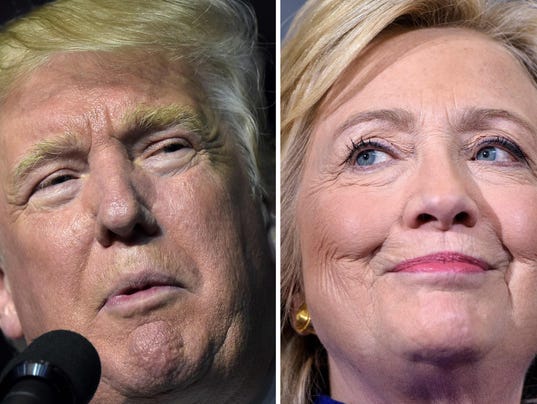
When speaking, he sometimes holds his elbows into his body as if protecting something. He repeatedly gestures with an “A-OK’’-type sign, and waves his open palms back and forth, like he’s playing an accordion. He forces a smile — mouth corners up! — looks self-satisfied and insincere at the same time.
When speaking, she emphasizes a point by shaking a right fist with her thumb out on top — a gesture that wouldn’t be so distracting if it weren’t so reminiscent of the one from whom she apparently picked it up, her husband, the former president, at his most didactic.
When Donald Trump and Hillary Clinton debate Monday night, they’ll express themselves physically as well as verbally. Their body language — movements, posture, facial expressions — may inadvertently reveal as much about them as their words. Consultants call it “leakage.’’
It’s one thing to repeat talking points; it’s another to control the message you convey with your body. And it’s one thing to be coached on such nuances, as both candidates have been; it’s another to remember it with 100 million people watching.
Ruth Sherman, a prominent communications consultant and speaking coach, analyzed the candidates’ body language for the USA TODAY NETWORK.
Trump’s body language
Although Sherman admires Trump’s communications skills, some of his ticks and tendencies drive her crazy, because they distract an audience from his message (“It’s called ‘noise.’ You just get sick of it.’’) or contradict it.
Trump’s forensic sins:
• The self-hug. Trump gestures with his arms stuck out and elbows held unnaturally close to his sides. “It looks like he’s protecting something,’’ Sherman says — undesirable in one who claims to be a strong leader.
• The A-OK. To the point of distraction, Trump forms his thumb and forefinger into the A-OK sign, except that the extra three fingers are curled instead of sticking out straight.
• The chop. It’s what it sounds like, an annoying hand reflex that’s drummed out of every novice scholastic debater.
• The accordion. With his palms open toward each other, he moves his arms back and forth for emphasis, evoking those mechanical monkeys crashing the symbols.
• The grimace. With seemingly Herculean effort, Trump turns up the corners of his mouth. But the rest of his facial muscles are not cooperating — check the eyes. It undercuts credibility and looks incredibly uncomfortable.
Clinton’s body language
Sherman says Clinton is well dressed and well groomed, uses her hands effectively and moves well. She particularly liked the way Clinton took the stage for her acceptance speech at the Democratic convention, moving from right to left and basking in applause from around the hall.
Among her flaws:
• The thumb-over. When most people make a fist, they tuck their thumb across their knuckles. But Clinton rests her thumb on top of her forefinger, which is fine — she doesn’t look like she’s going to slug anybody — but reminds us that the gesture was popularized by the 42nd president.
• The shrug. Clinton sometimes gives a little shrug while she’s making a point, which suggests subconscious uncertainty about what she’s saying.
Comparing the candidates
Sherman has more technical complaints about Trump’s body language, but feels he’s a much better performer and communicator than Clinton — partly because he practiced before a national reality TV show audience for 14 years and partly because he’s a natural.
However grating his Queens accent or distracting his idiosyncratic gestures, Trump has trained his audience to accept him as he is — “that’s Donald.’’
Since in a televised debate performance tops content, Sherman says, “it’s his to lose. Content is not enough. Words are not enough.’’But didn’t words sink President Gerald Ford in 1976, when he said in a debate with Jimmy Carter that the Soviets didn’t dominate Eastern Europe? She chuckles. “Gerald Ford was no Donald Trump.’’
[Source:-USA Today]
